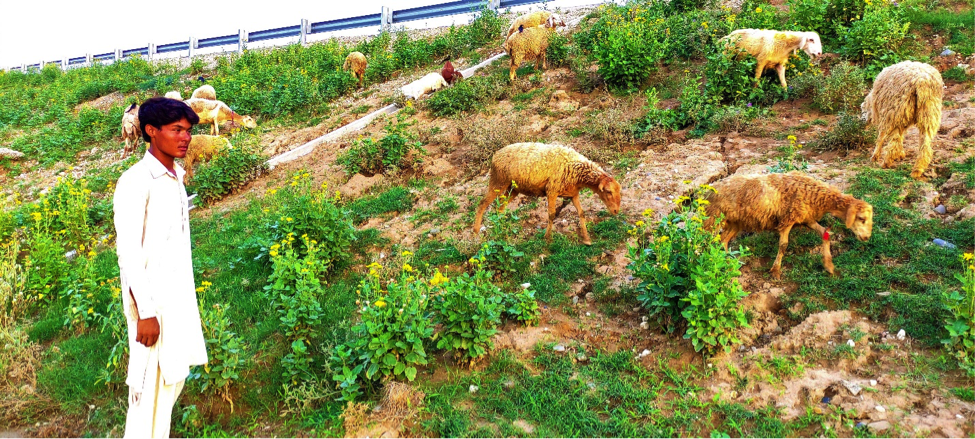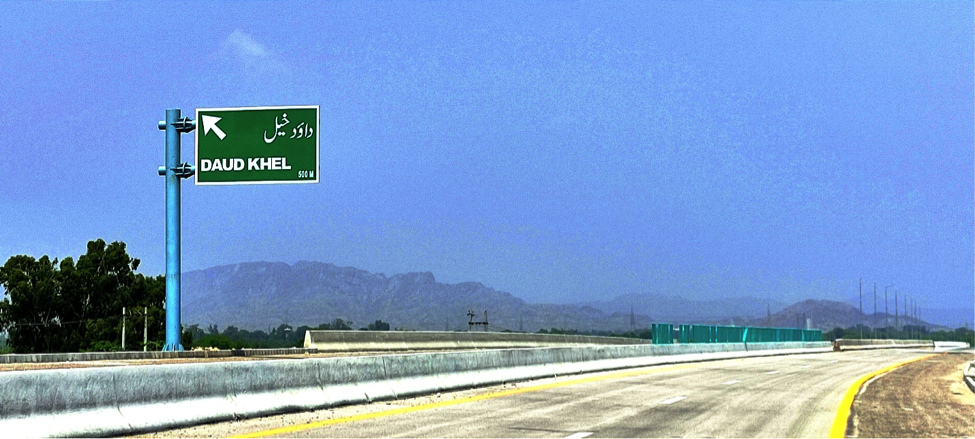CPEC’s M-14 to help boost livestock farming

Muhammad Owais while grazing his sheep near M-14 in Mianwali. [Photo/Tahir Ali]
by Tahir Ali
MIANWALI, Aug. 6 (Gwadar Pro) -Muhammad Owais, 16, is the son of a farmer who lives in the village of Muhammad Wala in Mianwali, Punjab. Hakla-Dera Ismail Khan Motorway (M-14), a project under China-Pakistan Economic Corridor (CPEC), passes through his village. In addition to agriculture, Owais’ family raises sheep, providing them with milk and wool, which they sell in hours of need. There are around 40 sheep and lambs in his flock. There is no pastureland for the young herdsman’s sheep. They eat brush, grasses, and weeds that grow in Muhammad Wala village. Owais grazes his sheep in green fields near M-14.
Muhammad Wala is one of the small villages that dot the landscape of Kamar Mushani tehsil of Mianwali. “The motorway has integrated with our village. It connected us to the rest of the country,” Muhammad Owais told Gwadar Pro. According to him, at the moment they could only sell their livestock in the animal markets of Kamar Mushani and the city of Rachel. However, the motorway would allow them to reach the cattle markets of Rawalpindi and Islamabad.
With the completion of M-14, travel time from Mianwali to Rawalpindi and other destinations would be greatly reduced with less stress for the road users, according to him.

M-14 passes through Daud Khel, Mianwali. [Photo/Tahir Ali]
Like Muhammad Owais, the livelihood of the majority of people living in rural D.I. Khan, Mianwali, and Attock districts mainly depends on agriculture and livestock rearing. D.I. Khan and Mianwali have some irrigated agriculture while Attock is mainly rainfed. Livestock, for the people of these districts, serve as the main economic bank that they sell in hours of need. The villagers of these regions mainly raise sheep, goats, and cows while keeping donkeys and camels for loadings.
“The motorway is great news for livestock owners to have easy access to markets to sell and purchase animals and to bring supplementary feeds from outside,” Muhammad Owais told Gwadar Pro.
Muhammad Muzammil, 27, is another resident of Muhammad Wala. While standing in the mung bean field, he said the CPEC road explored their village. “Who knew our village before this motorway? It has integrated us with the rest of Punjab and southern KP as well,” he told Gwadar Pro.

M-14 integrates the village of farmer Muzammil into the rest of the country. [Photo/Tahir Ali]
Besides agriculture, Muhammad Muzammil also grows cattle at home. “Rainwater destroyed mung bean crops near the Indus River. Agriculture and cattle ranching are the main sources of our survival. If your crops are damaged then you only have to rely on livestock to meet household expenses,” he told Gwadar Pro. He said there was a great demand for Desi Ghee and especially butter in the cities. However, market access is a problem.
Ataullah Khan from Kalowala village in Mianwali has grown different vegetables such as okra, cucumber, and greens. He also keeps a few chickens in his house as an additional source of income. “If we could supply our products to main regional vegetable markets, we would get a fair amount,” he toldGwadar Pro, adding they are anxiously waiting for the completion of M-14.
The district of Attock is one of the main producers of poultry products in the country. The government of Punjab recently approved a plan to distribute 3.5 million chickens across the province by June 2021 and the Attock district will receive a significant share. M-14 is all set to help Attock farmers send their poultry products across the country.

A beautiful view of grazing animals beside M-14. [Photo/Tahir Ali]
Livestock is a symbol of prestige and an additional source of income for farming communities of Pakistan. According to the Economic Survey of Pakistan 2021, more than eight million rural families are engaged in livestock production and deriving more than 35to 40 percent of their income from this source.
The four-lane motorway that starts from Yarik (D.I. Khan) on Indus Highway N-55 to Hakla on M-1 would play a crucial role in agricultural development with livestock as a key subsector.
Besides connectivity, the impact of M-14 will be felt in many ways, which means a spurt in local enterprises and small businesses to cater to the increased purchasing power of the farmers, more schools and health facilities supported by the influx of new prosperity in the area, more private and public transport, more food shops, more local production, and more construction of residential and commercial properties. Job opportunities will spring up and set off another set of income-generation activities.




